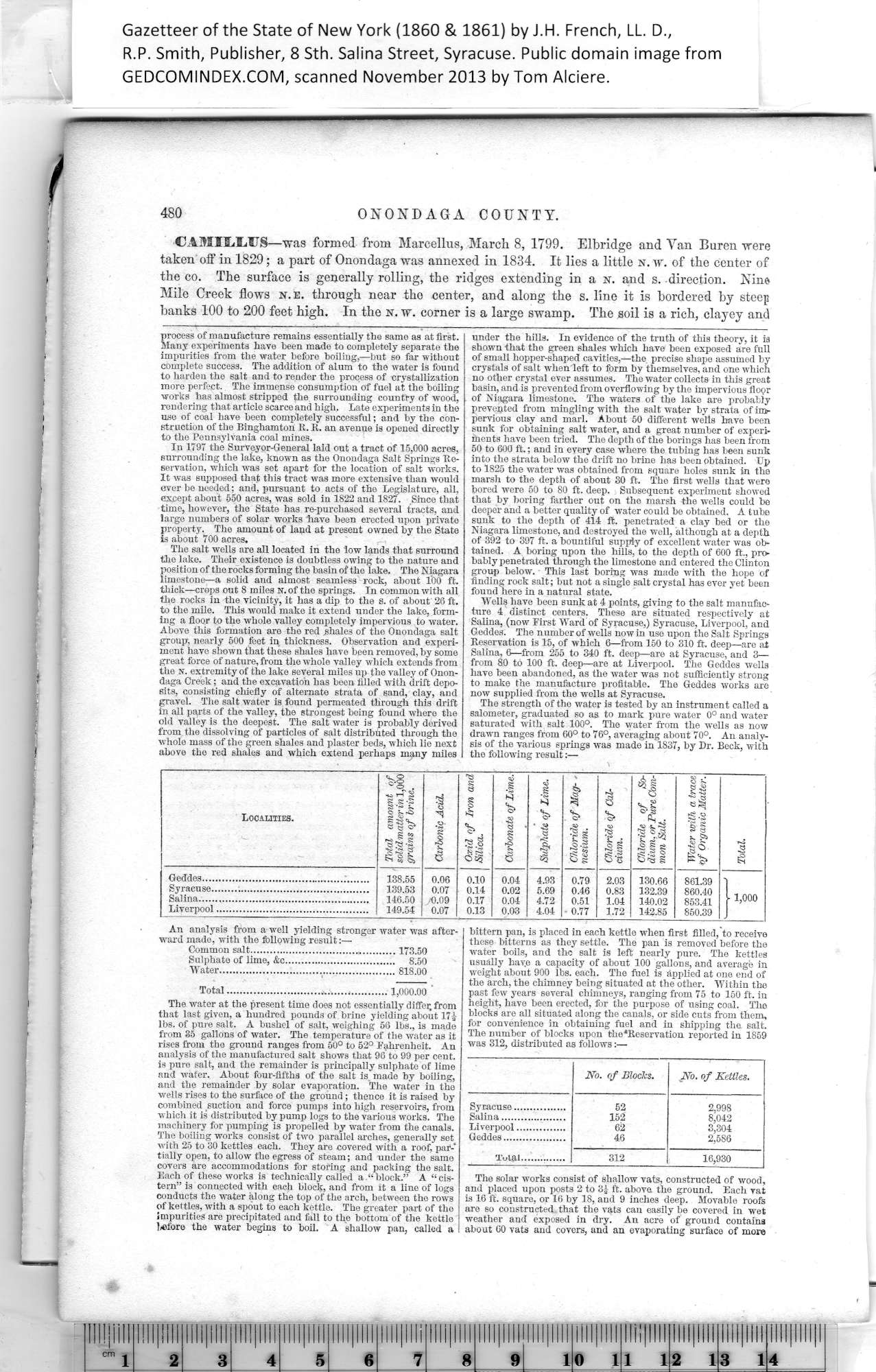|
process of manufacture remains essentially the same as at first.
Many experiments have been made to completely separate the
impurities from the water before boiliug,—but so far without
complete success. The addition of alum to the water is found
to harden the salt and to render the process of crystallization
more perfect. The immense consumption of fuel at the boiling
works has almost stripped the surrounding country of wood,
rendering that article scarce and high. Late experiments in the
use of coal have been completely successful; and by the con¬
struction of the Binghamton R. R. an avenue is opened directly
to the Pennsylvania coal mines.
480 ONONDAGA COUNTY.
CAMILLUS —was formed from Marcellus, March 8, 1799. Elbridge and Yan Buren were
taken off in 1829; a part of Onondaga was annexed in 1834. It lies a little n. w. of the center of
the co. The surface is generally rolling, the ridges extending in a n. and s. direction. Nine
Mile Creek flows n.e. through near the center, and along the s. line it is bordered by steep
banks 100 to 200 feet high. In the n. w. corner is a large swamp. The soil is a rich, clayey and
In 1797 the Surveyor-General laid out a tract of 15,000 acres,
surrounding the lake, known as the Onondaga Salt Springs Re¬
servation, which was set apart for the location of salt works.
It was supposed that this tract was more extensive than would
ever be needed; and, pursuant to acts of the Legislature, all,
except about 550 acres, was sold in 1822 and 1827. Since that
time, however, the State has re-purchased several tracts, and
large numbers of solar works have been erected upon private
property. The amount of land at present owned by the State
is about 700 acres. |
The salt wells are all located in the low lands that surround
the lake. Their existence is doubtless owing to the nature and
position of the rocks forming the basin of the lake. The Niagara
limestone—a solid and almost seamless rock, about 100 ft.
thick—crops out 8 miles N. of the springs. In common with all
the rocks in the vicinity, it has a dip to the s. of about 26 ft.
to the mile. This would make it extend under the lake, form¬
ing a floor to the whole valley completely impervious to water.
Above this formation are the red shales of the Onondaga salt
group, nearly 500 feet in thickness. Observation and experi¬
ment have shown that these shales have been removed, by some
great force of nature, from the whole valley which extends from
the n. extremity of the lake several miles up the valley of Onon¬
daga Creek; and the excavation has been filled with drift depo¬
sits, consisting chiefly of alternate strata of sand, clay, and
gravel. The salt water is found permeated through this drift
in all parts of the valley, the strongest being found where the
old valley is the deepest. The salt water is probably derived
from the dissolving of particles of salt distributed through the
whole mass of the green shales and plaster beds, which lie next
above the red shales and which extend perhaps many miles
under the hills. In evidence of the truth of this theory, it is
shown that the green shales which have been exposed are full
of small hopper-shaped cavities,—the precise shape assumed by
crystals of salt when left to form by themselves, and one which
no other crystal ever assumes. The water collects in this great
basin, and is prevented from overflowing by the impervious floor
of Niagara limestone. The waters of the lake are probably
prevented from mingling with the salt water by strata of im-
pervious clay and marl. About 50 different wells have been
sunk for obtaining salt water, and a great number of experi¬
ments have been tried. The depth of the borings has been from
50 to 600 ft.; and in every case where the tubing has been sunk
into the strata below the drift no brine has been obtained. Up
to 1825 the water was obtained from square holes sunk in the
marsh to the depth of about 30 ft. The first wells that were
bored were 50 to 80 ft. deep. Subsequent experiment showed
that by boring farther out on the marsh the wTells could be
deeper and a better quality of water could be obtained. A tube
sunk to the depth of 414 ft. penetrated a clay bed or the
Niagara limestone, and destroyed the well, although at a depth
of 392 to 397 ft. a bountiful supply of excellent water was ob¬
tained. A boring upon the hills, to the depth of 600 ft., pro¬
bably penetrated through the limestone and entered the Clinton
group below. This last boring was made with the hope of
finding rock salt; but not a single salt crystal has ever yet been
found here in a natural state.
Wells have been sunk at 4 points, giving to the salt manufac¬
ture 4 distinct centers. These are situated respectively at
Salina, (now First Ward of Syracuse,) Syracuse, Liverpool, and
Geddes. The number of wells nowin use upon the Salt Springs
Reservation is 15, of which 6—from 150 to 310 ft. deep—are at
Salina, 6—from 255 to 340 ft. deep—are at Syracuse, and 3—
from 80 to 100 ft. deep—are at Liverpool. The Geddes wells
have been abandoned, as the water was not sufficiently strong
to make the manufacture profitable. The Geddes works are
now supplied from the wells at Syracuse.
The strength of the water is tested by an instrument called a
salometer, graduated so as to mark pure water 0° and water
saturated with salt 100°. The water from the wells as now
drawn ranges from 60° to 76°, averaging about 70°. An analy¬
sis of the various springs was made in 1837, by Dr. Beck, with
the following result:— |

